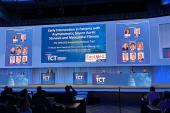EARLY TAVR: Delaying Valve Replacement Increases Risk of Poor Outcomes
With surveillance, conversion to acute valve syndrome happened frequently and was linked to worse clinical outcomes.

CHICAGO, IL—Patients with asymptomatic severe aortic stenosis who are watched until symptoms develop before undergoing TAVI are a greater risk of dying, being hospitalized for heart failure (HF), or having a stroke compared with those who have the procedure while still clinically asymptomatic, a subanalysis of the EARLY TAVR trial shows.
Those in the delayed-treatment group had become sicker than they were at baseline by the time they got their procedure, with evidence that many of them couldn’t walk as far as they could a few months before. These patients also had worsened self-reported quality of life and were more likely to develop atrial fibrillation (AF).
The 24-month postprocedure risk of death or stroke was 13.7% in those who had delayed TAVI and who were diagnosed with acute valve syndrome at the time of aortic valve replacement (AVR) conversion. In contrast, the rates were 6.2% in delayed patients with progressive valve syndrome and 6.1% in those randomized to early TAVI, respectively. Stroke occurred in 8.3% of those with a delay plus acute valve syndrome compared with rates of 2.7% and 2.3% in delayed patients with progressive valve syndrome and in those randomized to early TAVI, respectively.
“These findings provide a strong rationale for prompt intervention in patients with asymptomatic severe aortic stenosis at least to prevent progression to acute valve syndrome and poor outcome,” said Philippe Généreux, MD (Morristown Medical Center, NJ), in a presentation here last week at the American College of Cardiology (ACC) 2025 Scientific Session.
Whereas progressive valve syndrome is a mild progression that typically involves shortness of breath and an increase in HF medication from baseline, acute valve syndrome patients convert with more severe symptoms that may include syncope, NYHA class III/IV HF, AF, ventricular arrhythmia, LVEF < 50%, and, in some cases, cardiac arrest. Généreux said the worsening of symptoms was so sudden in some patients with acute valve syndrome that they were resuscitated either in the ER or by emergency medical personnel before being brought to the cath lab for TAVI.
“The interesting thing is those patients were literally asymptomatic 6 months before,” he said. “But very quickly they developed symptoms that were really severe. Between 0 to 6 months from randomization, 40% converted to AVR with acute valve syndrome; between 6 to 12 months, also approximately 40%; and the same between 12 and 18 months. So, 40% of patients at any given time on [the] surveillance strategy are going to convert with these severe symptoms.”
I think we’ve been sleeping on the fact that severe aortic stenosis is most likely a risk factor for stroke. Philippe Généreux
When Généreux and colleagues tried in multivariable analysis to see if they could predict which patients would end up in that worst case scenario while under clinical surveillance, they failed to do so.
“The model was very weak, the discrimination was modest at best,” he said. “The reality is that by waiting you are converting a simple case into a more complex case with more severe disease.”
Robert O. Bonow, MD (Northwestern University Feinberg School of Medicine, Chicago, IL), who discussed the subanalysis in the session, said the results are an important reminder that there is little gained in waiting to do TAVI. He wondered what the connection was between the stroke rate in the acute valve syndrome patients and the delay to treatment.
“These patients already had their TAVR,” he said. “So, [is] this related somewhat to the device that may have been used? The operators? The patients themselves? How do you explain that higher stroke risk?”
Généreux said he believes that it may be related to worsening aortic stenosis causing more calcium buildup on the valve, thus increasing the risk of microembolism and shedding of calcium in the brain.
“I think we’ve been sleeping on the fact that severe aortic stenosis is most likely a risk factor for stroke,” he told TCTMD. “We now have four randomized trials in asymptomatic patients—EARLY TAVR, EVOLVED, AVATAR, and RECOVERY—showing benefit either in reducing heart failure hospitalization or reducing stroke, which I think should be enough to drive the needle toward changing the guideline to give early AVR—TAVR or surgery—a class I indication.”
Current guidelines recommend routine clinical surveillance every 6 to 12 months in patients with severe aortic stenosis and no symptoms.
In the main EARLY TAVR trial, which was presented last year at TCT 2024, a strategy of early TAVI bested clinical surveillance, with a 50% reduction in the primary endpoint of death, stroke, or unplanned CV hospitalization at a mean follow-up of 3.8 years. The number needed to treat to prevent one event at 2 years was 6. There also was a 40% reduction in death, stroke, and HF hospitalization with early intervention.
In the clinical surveillance arm of the trial, more than 70% converted to symptoms by 2 years and underwent AVR, which is what spurred the subanalysis to look more closely at outcomes and clinical presentation between those randomized to early TAVI and those who received TAVI after a delay.
EARLY TAVR Subanalysis
The subanalysis included 832 patients: 444 who had early TAVI as part of the randomization and 388 who underwent TAVI a median of 11.1 months after being randomized to clinical surveillance. Severe AS was defined as aortic valve area ≤ 1.0 cm2 or aortic valve area index ≤ 0.6 cm2/m2 with mean transaortic gradient ≥ 40 mm Hg or peak aortic jet velocity ≥ 4.0 m/s.
Compared with baseline, delayed TAVI patients did poorer on the 6-minute walk test prior to their procedure, had a 4% increase in the development of AF, had declines in Kansas City Cardiomyopathy Questionnaire score, and had increases in levels of NT-proBNP.
Some baseline echocardiographic endpoints also changed significantly while waiting for symptoms: there were decreases in aortic valve area, increases in peak velocity and in mean gradient, a decline in mean LVEF, and an increase in LV mass index.
In all cases, TAVI was performed with the Sapien 3 or Sapien 3 Ultra valve (Edwards Lifesciences). The rate of death, stroke, or HF hospitalization was 14.9% in delayed AVR with acute valve syndrome versus 8.2% in those with delayed AVR and progressive valve syndrome and 6.8% in the early TAVI group (log-rank P = 0.008). All-cause death was 7.9%, 4.4%, and 3.8%, respectively (log-rank P = 0.14). HF hospitalization was 3.5%, 2.0%, and 1.6%, respectively (log-rank P = 0.27).
In analyses adjusting for age and sex, delayed AVR with acute valve syndrome was associated with a twofold increase in death, stroke, or HF hospitalization and a threefold increase in the risk of stroke following the procedure compared with early TAVI.
To TCTMD, Généreux said the argument for clinical surveillance no longer makes sense given the potential for harm incurred by waiting.
“We don’t want to wait until the acute symptoms develop [and] we don’t want this to be done in a chaotic way, but that’s what’s going to happen if we don’t plan,” he said. “Early TAVR means early evaluation, organized care, and treating promptly. We can’t sit back and wait for things to progress slowly [because] 40% of patients in a carefully done trial still presented with acute valve syndrome that increased their risk for death, stroke, and heart failure. For the people who say they can follow their patients every 3 months, I would say you can follow them every day but you’re still going to miss someone who converts rapidly to symptoms.”
Généreux said the numbers of asymptomatic severe AS patients who develop acute valve syndrome in the real world are thought to be even higher, with a recent analysis of more than 2 million patients showing a rate of more than 50% at the time of AVR.
L.A. McKeown is a Senior Medical Journalist for TCTMD, the Section Editor of CV Team Forum, and Senior Medical…
Read Full BioSources
Généreux P. Incidence and impact of acute valve syndrome before aortic valve replacement: insights from the EARLY TAVR trial. Presented at: ACC 2025. March 31, 2025. Chicago, IL.
Disclosures
- EARLY TAVR was sponsored by Edwards Lifesciences.
- Généreux reports consulting for Abbott Vascular, Abiomed, Edwards Lifesciences, Haemonetics, Pi-Cardia, Puzzle Medical, Saranas, Shockwave Medical, Teleflex, and 4C Medical. He reports equity in Pi-Cardia, Puzzle Medical, and Saranas.





Comments